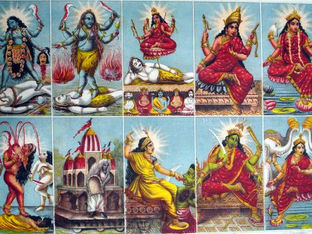
Parvati
The Goddess of Fertility
& Power
According to tradition, Adi Shakti, the primordial energy, has taken the form of Parvati. According to this story, Parvati was born as the daughter of Shiva's wife, Mena, and Himavan, the mountain king. According to another widely accepted tale, Parvati is the incarnation of Sati, Lord Shiva's first wife. The Goddess is revered widely across many cultures and traditions in Hindu mythology, where she is given an important position. She is known by a number of other names, including Uma and Gauri. She is symbolic of the holy feminine spirit and is linked to ferocity, strength, and devotion.
Iconography
Although Parvati is shown differently depending on the area, she is frequently shown with a yellow or white complexion, signifying her association with gender and purity. She is depicted with a green complexion in some parts of Southern India, indicating a darker shade. Parvati is depicted with two arms when she is with Shiva. In contrast, she is seen in her independent form with four arms, each carrying attributes such as a bell, lotus, rosary, or trident, or with Ganesha, her son, sitting on her lap. She frequently appears with either a lion or Nandi, the sacred bull and vahana of Shiva.
Parvati is also associated with, Yoni, which is shown along with Linga, an abstract representation of Shiva. Yoni signifies uterus or vagina, the gate of all births
Forms of Parvati
In Shakti tradition, she is Adi Parashakti herself and has various qualities and forms, ranging from terrifying mother goddesses who preserve cosmic balance and slay demons, to peaceful goddesses who protect their devotees. Her various manifestations rule the Hindu goddess culture, from local or village deities to well-known deities like Kali, Durga, and Annapurna. While in Vaishnavism, Lakshmi is considered the primordial goddess, and all other goddesses are believed to be manifestations of her divine energy Following are some prominent goddesses and group of goddesses regarded as the manifestations of Parvati:
Durga
Goddess Durga is a principal form of Shakti described as a warrior goddess and a protective mother. Her name means “invincible and unassailable”. According to the legend, she was created by male gods with the power to slay the buffalo demon Mahisasura to restore peace. Durga is depicted riding on a lion and killing the buffalo demon by cutting off its head. She represents the collective energy (shakti) of several gods and is hence shown with multiple arms holding the specific weapons of different gods. Durga is a predominant and the most beloved goddess in Hinduism and is also considered as the supreme mother. (Read: Durga)
Kali
Kali is the goddess of time, birth, and death, representing the eternal cycle of creation, preservation, and distruction. She embodies both the nurturing and destructive aspects of the divine feminine and is one of the most notable deities in Hinduism, she is also associated with the Vedic name of the fire, known as Kali (all-consuming). She is regarded as the most powerful and fearsome aspect of Shakti or Durga and has a frightening appearance recognized by her long lolling tongue and black complexion. Goddess Kali is also considered to be the supreme goddess in various Tantric traditions across India. (Read: Kali)
Navadurga
Navadurga is a group of nine manifestations of the goddess Durga or Parvati who are worshipped collectively. The names of goddesses vary in different texts. (Read: Durga)
Mahavidya
Mahavidya is a group of Tantric goddesses, often considered the manifestations of Kali. Each of them represents a distinct principle of existence and a path of self-realization. Although Mahavidya is listed in a group of ten, any goddess who offers vidya (correct knowledge), siddhi (attainment), and moksha (liberation) is called Mahavidya. The primary ten goddesses in this group are Kali, Tara, Tripura Sundari, Bhuvaneshvari, Bhairavi, Chhinnamasta, Dhumavati, Bagalamukhi, Matangi, and Kamala, led by goddess Kali herself. (Read: Mahavidya)
Matrikas
Matrika is a group of mother or warrior goddesses who are portrayed together in unspecified numbers. According to the Devi Mahatmya, Matrikas were created by Durga to defeat the demon army. The most widely recognized Matrikas are Brahmi, Maheshvari, Kumari, Vaishnavi, Varahi, Indrani and Chamunda. These goddesses are thought to have originated from attributes of different male deities. They represent the Shakti of these male deities in female form. (Read: Matrikas)
Annapurna
Parvati manifests as Annapurna, the goddess of food and nutrition. Once upon a time, the god Shiva and his wife Parvati fought about the state of the universe. Shiva believed everything, even food, was an illusion. Parvati, who oversees earthly affairs, became infuriated. She vanished to show how important she was. The entire planet was starving when she left. Even Shiva's devotees, and the other deities, had to beg for food. They discovered the only place with food left was a Varanasi kitchen run by Parvati in the form of Annapurna.
Annapoorna is depicted as youthful woman with red complexion, three eyes, and two to four hands. She is carrying a vessel of food and a ladle, while other two hands are in abhaya and varada mudras. Shiva is shown standing right to her with a bowl.
Jagaddhatri
Jagaddhatri an aspect of Shakti or one of the incarnations of Durga, particularly popular amongst the Shakta worshippers of Bengal. She is who sustain and nourish the universe. She is represented as seated on a lion, with a generous facial expression and an elephant beneath the foot of the lion. She has four arms holding chakra, conch shell, bow-arrow or one hand in Abhaya mudra. The elephant represents the ego of the gods.










